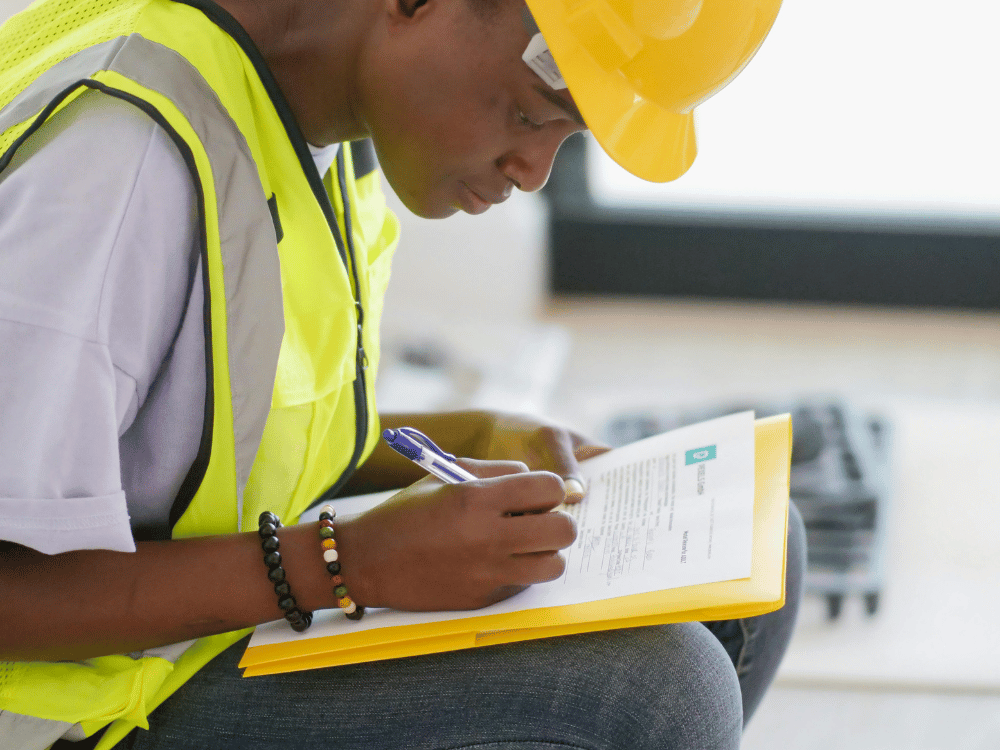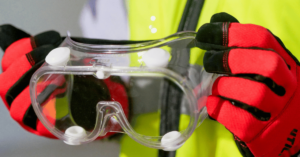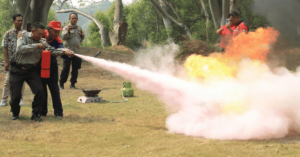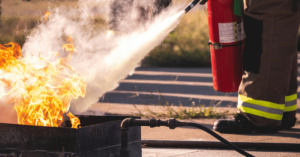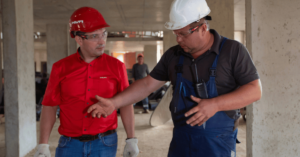Did you know that 5,000 people die annually from asbestos-related diseases in the UK alone?
This shocking statistic proves just why regular asbestos risk assessments are so important.
But what is included in these checks? How can TSW training courses help to improve your team’s knowledge? And who, specifically, needs to have that training?
TL;DR – How to Conduct an Asbestos Risk Assessment
We will go into more detail on what’s included in an asbestos risk assessment shortly. But, if you don’t have time, the core elements of the check can be broken down into five crucial parts:
- Identify Asbestos Containing Materials (ACMs)
- Assess the Risks to Health
- Determine the Likelihood of Exposure
- Evaluate the Control Measures in Place
- Document the Assessment
It’s important to highlight that a competent person should only carry out asbestos risk assessments. Competent people can be qualified by passing an asbestos awareness training course.
What is an Asbestos Risk Assessment?
Regulation 6 of the Control of Asbestos Regulations 2012 mandates that employers must schedule a risk assessment for asbestos before completing any work that may disturb the substance.
Deviating slightly from the format of a standard risk assessment, asbestos checks seek to define more precise details.
Those details should include confirmations around what work will be carried out, how much risk to health it represents, and what control measures are in place.
Where there is not enough information regarding the levels of asbestos in the building, employers must arrange for surveys to take place. Specialists conduct these reviews to determine the compound’s presence, type, and condition.
What is Asbestos Removal Risk Assessment?
Asbestos removal risk assessments define the hazards and risks of removing contaminated materials.
The removal of asbestos should only be carried out by licensed professionals. But this assessment also further defines the control actions employers or building owners need.
When inhaled, the fibres from asbestos can become trapped in the respiratory or digestive system and go on to cause life-threatening conditions.
When in good condition and undamaged, asbestos is not hazardous. But it was banned in the UK in 1999.
That banning order made it illegal to buy, sell, import or export any materials containing the compound. Interestingly, asbestos is not covered under the COSHH regulations, as it has been deemed dangerous enough to warrant its own legislation.
Despite this fact, around 1.5 million buildings and around 75% of schools in the UK are believed to contain it.
What is an Asbestos Register?
The asbestos risk register is a key component of robust asbestos management plans. Included in the documentation should be:
- Details of any asbestos found in the building.
- Confirmation of the compound’s condition.
- Findings of regular inspections.
- Details of any removal works.
- Additions after surveys when new areas of asbestos are located.
- Changed in asbestos condition.
What is the Purpose of an Asbestos Register?
The asbestos register exists so that the employer and building owner can stay completely aware of the presence and condition of asbestos on the property.
Details on the document should be updated regularly – at least once a year.
Updating the record regularly helps keep occupants safe from deteriorating compounds and defines when removal work is required.
What is an Asbestos Risk Assessment Form?
You can keep your business’s risk register assessment form on paper or in digital copies.
A good example of an asbestos register form would include details of the compound’s location on site, how much there is and its overall condition, among other checks.
You should also find space on the form to include imagery of the areas in question for complete clarity should the building be sold to another landlord.
What Are Some of the High-Risk Asbestos Products?
Asbestos can be found in many different areas of your building. Around pipework and insulation are the most common areas. However, some materials can contain more of the compound than others.
For example, insulation can be up to 85% asbestos, whereas asbestos cement only contains around 10-15%.
Other spaces and objects to review are:
- Fire breaks and ceiling voids: Can contain sprayed and loose packing asbestos.
- Pipe insulation and boilers: Some boilers and pipework can feature asbestos in moulded or preformed lagging (or cladding).
- Firebreaks, panels, partitions, ceiling panels: Panels can contain sprayed asbestos.
- Millboard and paper insulation: Some of these materials can include asbestos paper.
- Roofing, cladding, pipework, and water tanks: These objects can feature asbestos cement.
Importance of Conducting an Asbestos Risk Assessment
Asbestos-related lung cancer is one of the most common causes of lung cancer in the UK, behind smoking.
As this fact outlines, the main reason for asbestos risk assessments is to help keep staff and building occupants safe.
Another reason why risk assessments are essential is the threat of environmental contamination. Fibres from damaged or disturbed asbestos can settle on other surfaces. Disruption to these areas can mean fibres are ejected into the again, risking more frequent threats of inhalation.
However, implementing robust control measures as a result of the assessment can mitigate those environmental concerns.
How to Calculate the Asbestos Risk Assessment Score
Your risk assessment of asbestos should give you an overall score. Scores are given for every area containing asbestos reviewed.
During the inspection, the areas will be scored across four main categories:
- Occupant activity (scored 0-3): What type of setting is the asbestos in? And what type of activities usually take place there?
- Likelihood of disturbance (scored 0-3): How easy would it be to damage the asbestos in this area, causing fibres to be released?
- Maintenance activity (scored 0-3): What types of maintenance activities are likely to take place in the area? And how regularly are they completed?
- Human exposure potential (scored 0-3): How many people could be at risk of inhaling or ingesting asbestos fibres?
To calculate your asbestos risk assessment score, you would need to add the average three scores from across your likelihood of disturbance, maintenance activity, and potential human exposure totals, then add this to your occupant activity score.
Those calculations should give you an overall figure that sits somewhere in this table:
| Risk of Fibre Release | Score | Frequency of Checks/Action Required |
| High | 18 | Urgent action/removal |
| Medium | 14-17 | Seal and monitor annually |
| Low | 9-13 | Monitor every six months |
| Minor | 1-8 | Monitor annually |
How to Conduct an Asbestos Risk Assessment in 5 Steps
Thorough asbestos risk assessments can be completed by mapping the process over five crucial steps.
These steps exist because getting this area of asbestos control right is incredibly important. As mentioned, non-compliance can significantly affect your building occupant’s health. But it can also mean financial penalties for the employer or building owner. For example, Swift Property Management Ltd was fined £25,000 for failures in their approach.
This five-step system ensures that every area of the risk is reviewed and confirms that documentation and communication of your findings happens once all checks are complete.
1. Identify Asbestos Containing Materials (ACMs)
Firstly, you will need to conduct a visual review of the site to determine the existence of ACMs. This is where an asbestos awareness training course from TSW Training imparts crucial wisdom, highlighting where asbestos might be found.
Additionally, at this assessment stage, the competent person should have visibility of the building’s asbestos risk register to ascertain its history with the compound.
As a further step, the competent person should also set up feedback sessions with management and employees to qualify any further information that may not appear on the survey.
2. Assess the Risks to Health
In the next step, the assessor should outline who is at risk from airborne fibres. Those closest to the asbestos are most likely to be affected.
However, because these microscopic fibres are odourless, tasteless and invisible to the naked eye, more people could be at risk than those in the immediate vicinity.
3. Determine the Likelihood of Exposure
In this step, you will review how busy the area around the asbestos is. If, for example, the ACM has been identified in the locked store cupboard of your small office, then you can reasonably say who and how many people have had access to that area.
However, a wider assessment must be conducted if the ACM has been detected in an area of heavy footfall.
4. Evaluate the Control Measures in Place
At this point, it’s important to note that, in most cases, you cannot eradicate asbestos exposure. However, this process aims to mitigate the risk as much as possible.
Some example control measures are:
- Installing ventilation systems around the areas identified to have ACMs.
- Providing adequate PPE for work around ACMs.
- Wetting and enclosing certain types of asbestos to prevent fibre spreading.
- Ensuring appropriate disposal of ACMs.
- Completing decontamination works on all PPE following works.
- Establishing emergency procedures.
5. Document the Assessment
The final step of an asbestos risk assessment is to document your findings. In this report, it’s important to include details such as:
- Identified ACMs
- Who would be affected?
- What control measures are in place?
- Suggestions for updated measures or process improvements
- Who should implement the measures?
- How long will the work take?
Once you have a detailed assessment report, it’s good practice to circulate this with your employees. Feeding back the findings from your review will demonstrate health and safety buy-in from the management team – a crucial element to fostering a strong safety culture in the workplace.
Frequently Asked Questions (FAQs)
Here are some frequently asked questions regarding asbestos risk assessments.
What is an Asbestos Risk Assessment Example?
A good example of an asbestos risk assessment would be to review a site to detect the compound. The next step is to identify the level of risk involved and what control measures should be implemented. Finally, ensure all assessment findings are documented and shared with staff or building occupants.
Who is Responsible for Managing the Risk of Asbestos?
The employer or building owner is responsible for scheduling regular asbestos risk assessments. Alternatively, in the workplace, it can be the responsibility of a Line Manager or another competent person to carry out assessments.
When Was Asbestos Banned In The UK?
Asbestos was banned in the UK in 1999.
Conclusion
The presence of ACMs at your property could pose profound implications for your employees and the business’s bottom line.
However, in most cases, it’s not possible to completely eradicate the compound from your site. That being said, you can ensure the risk to your staff is as low as possible through asbestos risk assessments.
Enrol your team on an asbestos awareness course today with us at TSW Training and start improving the knowledge level in your business.

